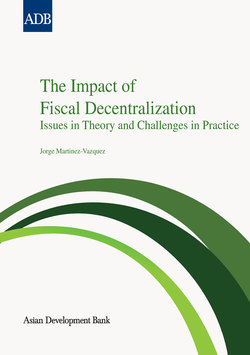Читать книгу The Impact of Fiscal Decentralization - Jorge Martinez-Vazquez - Страница 6
The Causes and Basic Theory of Decentralization
ОглавлениеCountries begin decentralization processes for different reasons. Some are searching for a more efficient—and leaner—public sector, while others are disenchanted with the performance of planning and centralized policies (e.g., socialist economies). There are often grassroots demands to achieve democratic ideals. On the other hand, some movements are designed to contain or to appease centrifugal forces, ethnic conflicts, and/or separatism, and to diffuse social and political tensions by allowing local cultural and political autonomy. There may even be some political opportunism using decentralization for electoral objectives and/or just a desire to not be left behind in this popular form of institutional reform. While governments do not generally decentralize to pursue greater macro stability and economic growth, decentralization may impact upon these.
“Decentralization” generally means the devolution of decision-making powers. A related concept is “deconcentration,” in which operations are decentralized, but decision-making powers are not devolved. For example, many observers state that Bangladesh is a deconcentrated system, in which local governments are still subject to the control of central authorities, as opposed to a decentralized one, in which local governments have autonomy to set their own priorities and decide how best deliver public services. In addition, decentralization does not necessarily denote an erosion of central control nor of powers over issues and processes with national dimensions.1 Instead, it has political, administrative, and fiscal dimensions that are replicated more or less completely in different vertical spheres (i.e., regional and local).2
In recent years, there have been multiple extensions of the traditional theory of fiscal federalism (or the organization of intergovernmental fiscal relations) first developed by Oates in 1972. Viewing government as a benevolent agent, he created a decentralization theorem, which states that in the presence of diverse preferences and needs, provision of services from a decentralized government will lead to increased citizen welfare. This occurs because decentralized government leads to information advantages and more flexibility in adapting to citizens’ needs and preferences, as emphasized earlier by Hayek (1945). Today, the growing second-generation literature is based on the theory of “public choice,” assuming a political economy with selfish officials, as opposed to the benevolent agents in the previous literature. A branch of this literature, known as market-preserving federalism, focuses on incentives for government officials not to deviate from good behavior and emphasizes the role of decentralization as a mechanism to control an intrusive, expansive public sector and to support effective private markets (Weingast 1995, McKinnon 1997).
Classical federalism and the Tiebout hypothesis (addressing the competition among local governments and the mobility of individuals to find their preferred package of services) play major roles in the theory of local public finance.3 Unlike the case of pure Samuelson goods (in which the addition of individuals does not diminish the amount available to others and no one can be excluded from its consumption), the efficient decentralized provision of local goods (with crowding in consumption and some excludability) is possible via the mechanism of mobility of households (i.e., “voting with their feet”—that is, moving—and sorting into homogenous communities). This concept is important to the understanding of decentralization in the United States (i.e., increased efficiency in the public sector), but it is not necessary to justify the advantage of fiscal decentralization in delivering more efficient outcomes in the delivery of public services. In fact, household mobility across local jurisdictions, like in the United States, hardly exists elsewhere.
The classical principles for decentralization design are well traveled across countries and over time. Hundreds of decentralization programs proposed by the Asian Development Bank, the International Monetary Fund, the World Bank, bilateral donors, and policy advisors have been inspired by these principles. After certain design issues have been addressed (e.g., hard budget constraints), the classical framework has been quite successful.
But decentralization is not an automatic remedy. The dangers of decentralization have been listed by many, and include a lack of capacity causing macro instability (Prud’homme 1995, Tanzi 1995). Others have tracked the diversion of funds in decentralized settings (Reinikka and Svensson 2004) while still others have warned of the dangers of capture by local elites (Bardhan and Mookherjee 2000).
Thus, is uniform central provision the right counterfactual for decentralization? It may not be if central governments are able to diversify and customize the provision of public services similarly to dentralized governments. However, further questions are raised regarding whether deconcentration can be as efficient as decentralization because of the lack of information and the lack of interest in diversifying the provision of public services. Further, it is questionable how diversity, complexity, proximity of local officials, political constraints, accountability, incentives, corruption, and state capture by local elites affect the success of decentralization.
Until recently, hard quantitative evidence has been scarce on the impact of decentralization, as it is difficult to isolate its effect from other processes in society and institutional changes in the public sector. The econometric issue of the endogeneity issue is also a key factor. Thus, there is need to evaluate whether decentralization is the cause of certain outcomes or simply the effect of other ongoing processes, such as democratization or economic growth, and statistical studies need to control for the possible presence of reverse causation.
